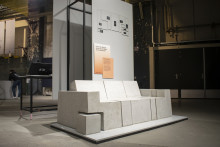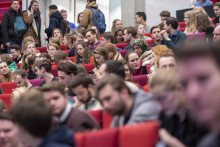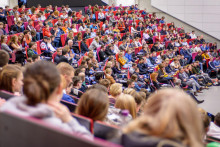The University of Twente is represented by seven projects at Dutch Design Week. Among them is the aforementioned couch made of radioactive waste. ‘Yes, it really is made of radioactive materials,’ confirms David Claassen, Master student of Industrial Design and one of the creators of ‘Nuclear Sitdown’. ‘And no, it is not dangerous,’ he answers the next question.
762 liters of radioactive waste
The installation was made together with the Dutch radioactive waste management facility COVRA. The company provided the waste, which was then ground and mixed into concrete – from which the couch is made of. ‘It is the same concrete COVRA uses to store radioactive waste. It includes special husk that prevents the material to radiate into the environment.’ Meaning, it is safe to sit on.
The sofa is meant to show how much radioactive waste we produce in the Netherlands each day and to trigger a discussion about this issue. It consists of 762 liter of low- and middle radioactive waste and a small block of 12 liters of high radioactive waste. What does the public at Dutch Design Week think of this installation? ‘Most of the time they are a little scared at first, but they are mainly curious,’ answers Claassen. ‘They ask a lot of questions and once we explain they even sit on it.’ After its premiere appearance in Eindhoven this week, the students hope to place the couch in a museum or a gallery.
Game for everyone
‘Feel it, find it, flip it.’ That is the basis of OMNI, a game designed specifically for blind and visually impaired people. ‘As it turns out, though, it is suitable literally for everyone,’ says Michelle Sudjito, Creative Technology student and one the designers of OMNI. ‘It started as a study project. We wanted to create a reaction game which does not involve sight, because there are very few of those available.’ The game is based purely on touch. It involves several cups that vibrate. The players need to feel for the vibrating cup, find it and flip it, which earns them points.

‘Many visitors have asked if they can buy the game. The demand is certainly there,’ says Sudjito. ‘Our end goal is to sell it, but first we want to develop it further. I would personally like to dedicate my bachelor thesis to it. It was even suggested to us that the game could be useful for people with dementia or people recovering from stroke, for example. There are no exclusion. Anyone can play it.’
Interactive table
Would you like your table to guide you towards healthier eating habits? Then the ‘Interactive Dining Table’, developed by UT researchers Juliet Haarman and Roelof de Vries, might be the right fit for you. The table is equipped with 8000 LED’s and nearly 200 sensors, enabling it to measure and react to behavior of people sitting at it.
‘The idea is to measure how people behave and influence each other while we eat,’ explains Haarman. ‘A lot of eating moments happen with others, but basically all food interventions are focused on an individual. Yet, if you are on a diet it’s very hard to stick to it in a social setting. The table can measure how much you put on a plate, how many bites you take, how fast you eat and so on. It can also provide direct feedback and hopefully stimulate healthier eating behavior.’ The table will soon be placed in the new TechMed center at the UT, where the researchers will conduct experiments with it.

It is still possible to see all the installations at Dutch Design Week. The event is held from the 19th until the 27th October in Eindhoven.
Seven UT projects
The following projects by UT students and researchers are being presented at Dutch Design Week.
Nuclear Sitdown by David Claassen and Sem Lootsma
OMNI game by Michelle Sudjito, Anouk de Graaf, Connor Stork, Niels Kadijk, Sanne Metten, Anna van der Linden, Timo Petersen, Kai Ferdelman. Supervisors Robby van Delden and Dennis Reidsma
Wearable Breathing Trainer by Geke Ludden, Lara Siering, Angelika Mader, Toms Bernhards, Hellen van Rees, Eliza Bottenberg, Boony Thio, Pascal Keijzer, Jean Driessen, Ben Bulsink
Interactive Dining Table by Juliet AM Haarman, Roelof AJ de Vries, Hermie Hermens and freelancer Emiel Harmsen
Journalist of the Future City by Anouk Geenen, Julieta Matos Castaño, Mascha van der Voort, Peter Paul Verbeek
UNFOLD by Tim Velthuis, Jelle van Dijk
FleXo: Flexible Exoskeleton for Therapeutic Touch by Kristin Neidlinger, Edwin Dertien, Kelly van Tol, Naveen Setty







